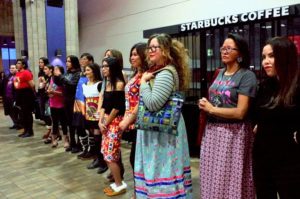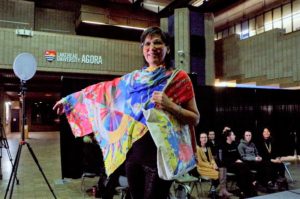Inaugural Thunder Bay Indigenous Fashion Week closes with Indigenous runway show

By Rick Garrick
THUNDER BAY— A group of Indigenous models and fashion designers enjoyed the opportunity to showcase Indigenous fashions at the Thunder Bay Indigenous Fashion Week fashion show on Dec. 19 at Lakehead University.
“It was amazing — it was so good!” says Janet Napash, a fashion designer and artist from Chisasibi, Que., who works at Dennis Franklin Cromarty First Nations High School in Thunder Bay. “I really appreciated the opportunity for them to be able to showcase what it is that I love doing. And that’s the only way I feel, is just excited.”
Napash says the collection she shared at the fashion show featured 10 of her own original painting designs on a range of clothing, including sweatshirts, t-shirts, dresses and leggings.
“I found a way to be able to share my paintings, not necessarily by selling them but by putting them on clothing,” Napash says. “So that is my way of sharing my paintings.”
Napash says her goal is to expand her collection in the future to include baby clothing.
“I have a new line coming up in the spring with all new images,” Napash says. “Each painting has a story to it.”
Beverly Bannon, a Fort William First Nation citizen and one of the models, enjoyed modelling a couple of fashion items featuring Norval Morrisseau’s art.
“The scarf is Norval Morrisseau’s art and the same with the bag,” Bannon says. “It feels amazing — I feel comfortable honouring Norval Morrisseau.”

Bannon says the young models were excited about trying on the Indigenous fashions in the change room prior to the fashion show, which was held in the Agora.
“I think [Indigenous Fashion Week] was amazing, and they should have more because we need venues like this,” Bannon says. “The first time I remember modelling was with [the late Elder] Freda McDonald when she designed her clothes, and that’s the last time I’ve actually seen something like that. I was eight years old.”
Rebecca Mekanak, a Thunder Bay resident who previously participated in a fashion show about 20 years ago, says the fashion show was fun.
“Nowadays it is a lot more fun because the designer is Indigenous, so I feel more connected to the clothing,” Mekenak says, noting that she modelled one of Napash’s medicine wheel designs. “She told us all to be confident and to have fun, to be ourselves.”
Zhaawan Aanakawad says the fashion show went well for him, noting he modelled his own clothing that he wears every day.
“I never thought my every day look would be presentable for the runway, but here we are,” Aanakawad says. “I do my own beadwork — it’s just something I learned a couple of years ago and I try to bring my culture into my life every day. I carry my tobacco bag and I’ve got my medallion and my beaded coat.”
Shari-Lyn Safir, a professional model, says she was proud to support and be a part of Thunder Bay Indigenous Fashion Week, which was held from Dec. 17-20.
“It’s about time and I’m really impressed with the designs,” Safir says. “In fact, I’ve asked one of the designers if I could buy a dress that I particularly like.”
Safir says the models did a “good job” during the fashion show.
“A lot of them have never ever done this,” Safir says. “I think this will be like: ‘Remember that first time we saw the fashion show?’ There will be more.”


